Run: To the Port of Last Resort
Written by Amen Gabre and Illustrated by Faith Mutum
A BOOK by ME - True Stories Written by Kids for Kids
Two talented young people collaborated to create the storybook about Holocaust survivor Doris Fogel. Young Amen Gabre, originally from Ethiopia, had a passion for learning more about the Holocaust. Perhaps the stories she learned from my work reminded her of the humanitarian crises in her own country. Our young artist Faith Mutum used her extraordinary talent to create the art to match the text Amen wrote. I’ll never forget the three of us having lunch with Doris one afternoon to prepare the girls to write her story. What a unique opportunity to connect the past with the present, allowing the teens to gain personal insights into history.
Doris, with a warmth that contrasted the weight of her past, shared stories that were both heart-wrenching and inspiring. The girls and I listened intently, at times with their eyes wide with disbelief as they absorbed the horrors the Jewish people faced during WWII. Doris’s talk was filled with moments of humor, reminding me of the strength of the human spirit. The girls shared about their own lives, their challenges and their dreams, bridging the generational gap and finding common ground. Doris is gone now but her story lives on because of two talented girls taking on the challenge of preserving her story for young readers.
Deb Bowen
Executive Director Understanding Works
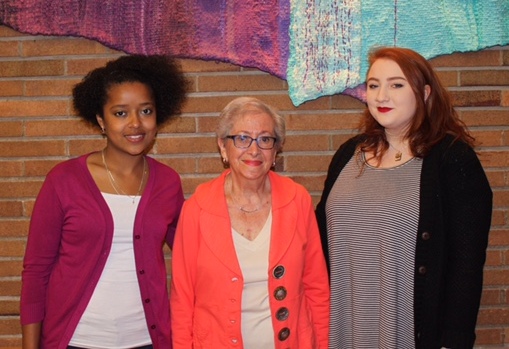
Author Amen Gabre, Doris Fogel and illustrator Faith Mutum
“It was our pleasure to meet and hear the story of Jewish Holocaust Survivor Doris Fogel firsthand when she came to speak in our city. Over lunch, we learned even more about this amazing woman who has shared her story with thousands of students. We are the lucky ones who get to document it for the future generation. We hope you learn from this project and make a promise to yourself to be tolerant to those who are different from you.”
Amen Gabre, Author
Faith Mutum, Artist
 “Doris is a fearless woman. She has survived the darkest times in world history, and she inspires me to become an independent person with a humble heart.” – Amen
“Doris is a fearless woman. She has survived the darkest times in world history, and she inspires me to become an independent person with a humble heart.” – Amen

“During the interview, Doris gave me a very good look into history. Her personality is very full of life and down to earth. It was a privilege to meet her and help share her story.” – Faith
Doris Warschawski Fogel – Jewish Holocaust Survivor
Doris [Warschawski] Fogel, daughter of Arno and Edith Warschawski, was born in May of 1934 in Berlin, Germany. A year and a half after Doris’ birthday her father, age 29, died of natural causes. Her young mother had a semi-nervous breakdown. Thankfully, mother and daughter were befriended by a couple and their small son in their apartment building. They soon became Doris’ “aunt and uncle,” and their son became her “cousin.” They were Edith’s and Doris’ lifeline that would eventually lead them to Shanghai, China.
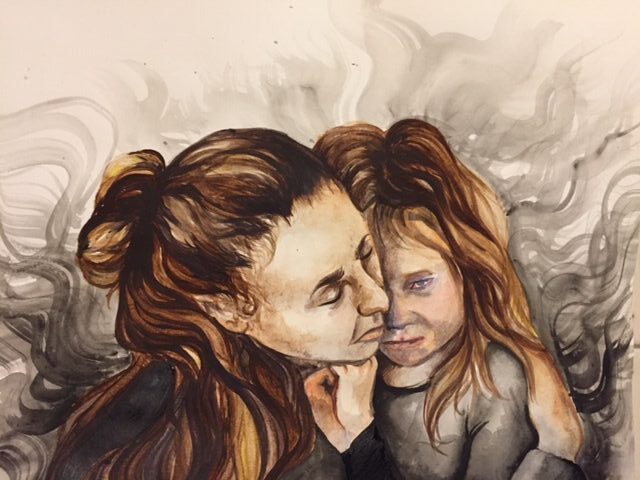
Mother and daughter spent most of their time with their new “protectors” and led a relatively peaceful and quiet life until November 9, 1938, the Night of Broken Glass. It’s forever known as “Kristallnacht,” when the Nazis burned synagogues, vandalized Jewish homes, schools and businesses, and killed innocent Jews. No one could have foretold what horrors and hardships the coming years would bring to millions of Jews and others. The next morning, the streets were a virtual ice rink of broken glass and sodden ash. The police stood by and did nothing. The firefighters rushed to the scene – ignoring property owned by Jews to instead protect buildings owned by non-Jews.
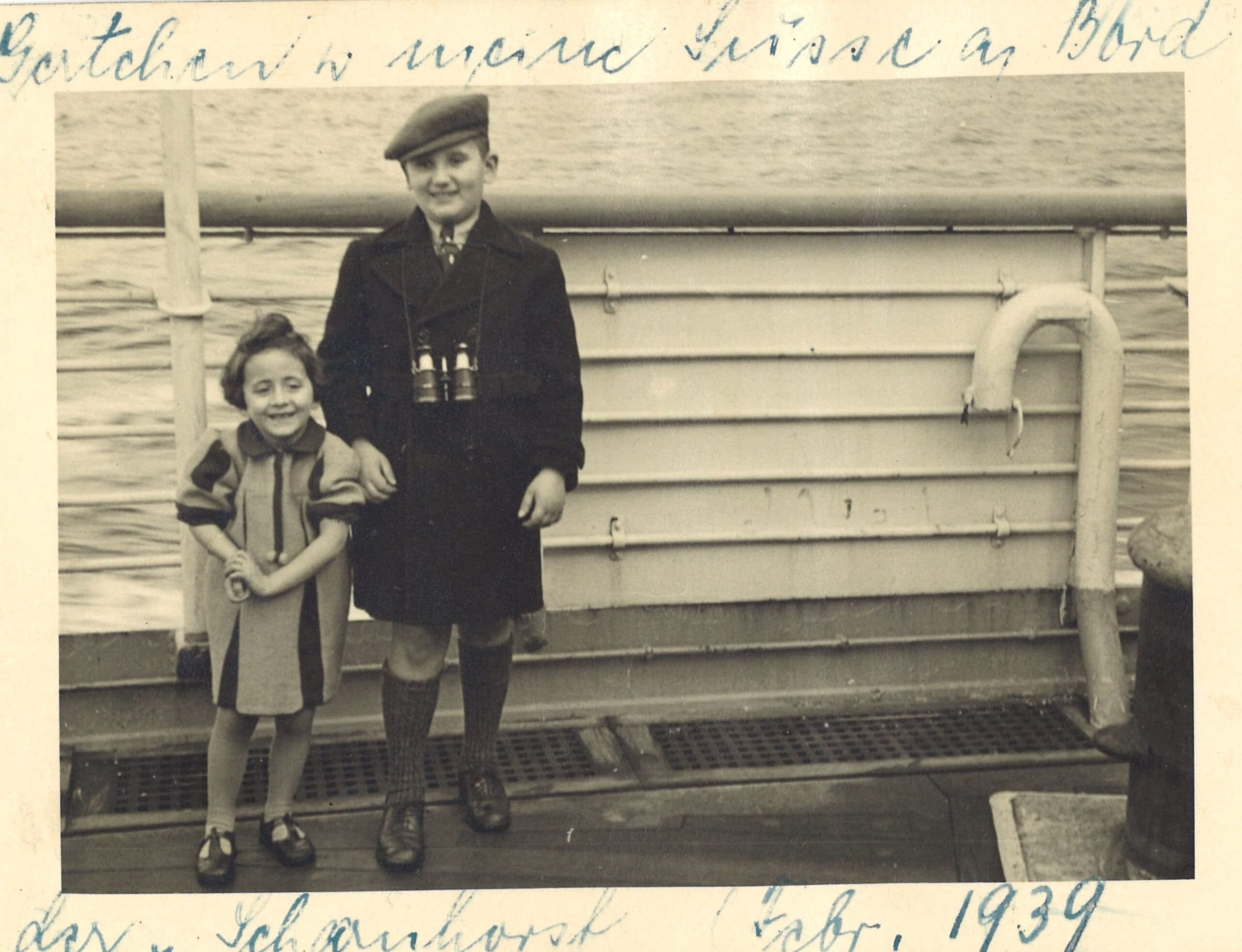
Doris with her cousin aboard the ship Sharenhorst on way to Shanghai, China in 1939
For those who were able, it was time for Jewish families to leave Europe. Some of Doris’ relatives tried to escape on an ocean liner called the SS St. Louis. The ship left Germany with over 900 Jewish refugees and was denied entry to Cuba, the United States and Canada. They sailed back to Europe, defeated. Many of them died in the Nazi concentration camps, including Doris’ relatives. Sadly, she and her mother would not learn about their deaths for many years.
Her aunt and uncle managed to arrange passage from Bremerhaven on the ship Sharenhorst in January 1939. At that moment they became refugees, outward bound for Shanghai, China, the only place in the world that required no entry visa. Indeed, Shanghai didn’t care who came ashore in the Metropolis of the East. People called it the “port of last resort,” which became home to 20,000 Jewish Refugees. Doris remembers the bright red “J” stamped above her mother’s name, identifying her as a Jew, and the word “Sara” below her name. Every Jewish woman was called Sara and every Jewish man was called “Israel.” Jews simply lost their identity. The Nazis tried everything they could to dehumanize the Jewish people. Edith tried to convince her father and her in-laws to leave Berlin. However, the older generation did not and could not believe things were going to get that bad.

After the month-long ocean voyage, Doris settled into her new life in Shanghai. When World War II started in 1941, the Japanese occupied Shanghai. Being allies of Nazi Germany, Shanghai mandated that all Jewish refugees live in a poverty-stricken, filthy and unsanitary area of Shanghai called Hongkew. In this one-square-mile area lived 20,000 refugees. As prisoners of war, they were not allowed to leave the area without permission from the Japanese. Overcrowding, poverty, hunger, disease and even prostitution became facts of life. Life in Shanghai was primitive, and staying healthy was a constant problem. Head lice was a common occurrence among the children, Doris being one of them. In the camp where her mother, aunt, uncle and cousin lived, there was a small room for the five people. They ate there and slept there (while bed bugs had a heyday in the bed Doris shared with her mother). There was no flush toilet, and they were expected to use the “Honey Pot” that the other inhabitants of the lane were using. The Honey Pot was a portable toilet; every morning one of the Chinese workers would come to collect the excrement which was later turned into fertilizer.
This is where Doris and her family spent eight challenging years of their life. The unexpected happened on July 17, 1945 when their ghetto became a target. The Allies bombed a Japanese radio station near her school. Due to the quick thinking of her teachers, the children were told to crouch under their desks and remained safe. What seemed like hours but was only two minutes, the all clear siren was heard. It took quite a while before the kids were reunited with their parents. A month later, on the 15th of August after the United States dropped the atomic bomb on Hiroshima and Nagasaki, Emperor Hirohito announced the unconditional surrender of Japan. On September 2nd, President Harry Truman officially proclaimed “V.J.” day as the Japanese surrender was signed aboard the U.S. Battleship Missouri at 10:30 a.m.
In April of 1947, Doris and her family boarded an American Troop Ship, the SS General Gordon, and on May 17, 1947 she saw her first glimpse of America when they passed under the Golden Gate Bridge in San Francisco. By then, thirteen-year-old Doris weighed a mere 65 pounds. She and her family were both elated and saddened. They cried for those who didn’t make it, those who ended up in Hitler’s ovens. Later, they would learn her mother’s in-laws died at Dachau and her mother’s father died in Sachsenhausen camp outside of Berlin, Germany.
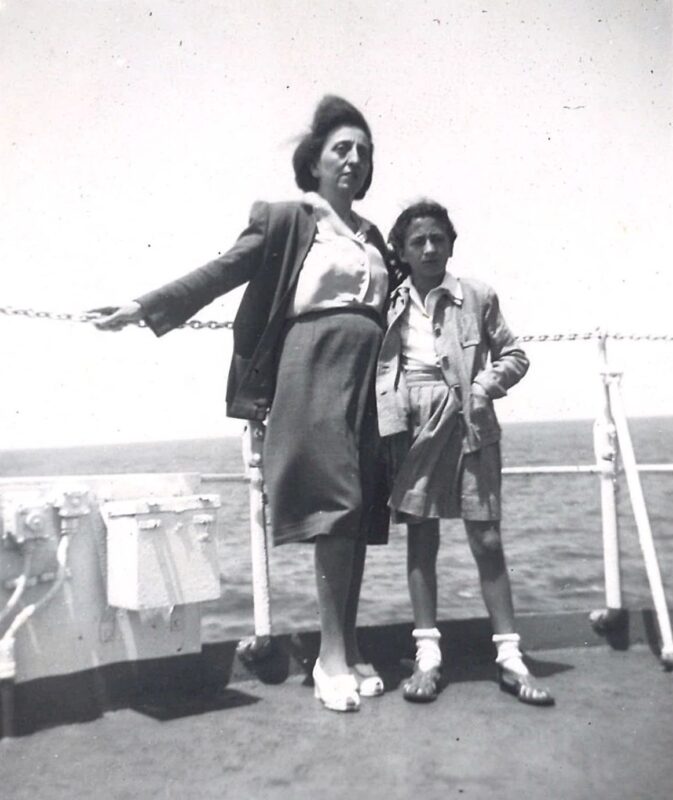
Doris and her mother aboard the SS General Gordonon their way to America in 1947
Upon her arrival in San Francisco, Doris got to take a bath. It was the first one she had been able to take in many years. She had plentiful bread for the first time in a long time. Her bed didn’t move because there were no bedbugs. She was clean, well fed and safe at last. All Jewish refugees had to have a sponsor in America. Theirs was in a place called Peoria, Illinois, so this is where Doris began a normal life as an American teenager. Soon, she gained weight and became a regular pimple-faced teen like her peers.
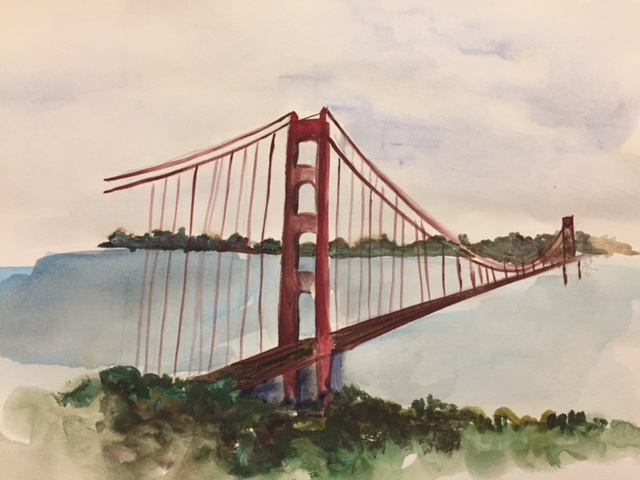
In 1961, Doris married Sam Fogel, an attorney from Fort Wayne, Indiana. Their three children, two boys and a girl, were born and raised in Ft. Wayne. During her years there, Doris twice served as President of Congregation Achduth Vesholom, the Reform Temple, as well as served six years as President of the Ft. Wayne Jewish Federation. After Sam’s retirement, Doris was hired as the Executive Director of the Ft. Wayne Jewish Federation. Two weeks before her retirement, Doris received the Sagamore of the Wabash, the highest honor bestowed by the Governor upon a Hoosier resident. This prestigious award was for the countless talks in schools and her volunteer work in various organizations.
Today, Doris is a widow and lives near her children in the Chicago area. Still speaking much of the time, she uses the Hebrew word “Zachor,” which means simply “remember.” She knows we must remember what happened during World War II and try to prevent it from happening again. Doris would like to leave readers with a lesson of hope and courage. It would be a great delight to her if you take this away from her story: stand upright even when others are bending, and speak out even when it’s politically incorrect.
 Run: To the Port of Last Resort
Run: To the Port of Last Resort
A BOOK by ME, a book series developed by Deb Bowen, empowers students to preserve history by telling the story of unsung heroes in our communities. For the young participants, it’s a guided cross-curricular project that gathers stories of people who do amazing things but have received little or no recognition. Students learn how to publish a picture book that is a primary source document with photographs and a biography.
Since 2003, Deb Bowen has been arranging meetings between students and individuals from the WWII generation. This intergenerational storytelling results in unique storybooks written and illustrated by kids for kids in the A BOOK by ME series. More about Deb Bowen >





